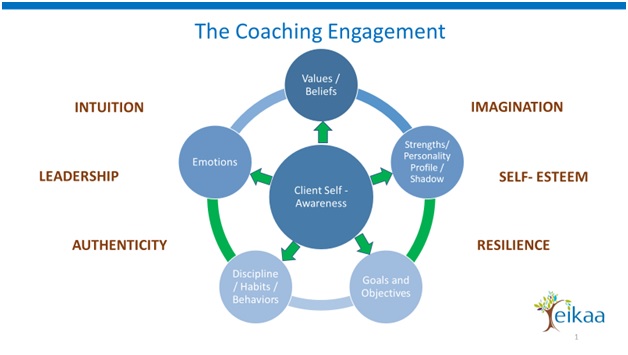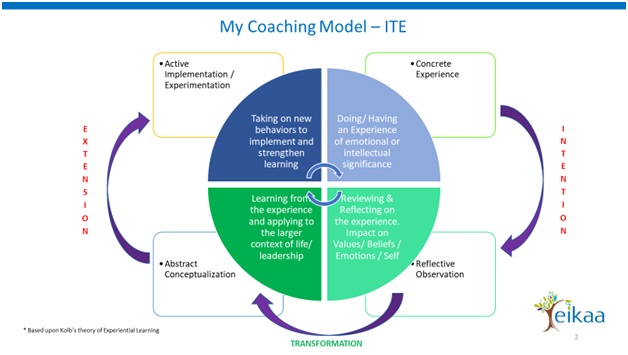A Coaching Model Created by Jasrin Singh
(Life Coach, SINGAPORE)
As an Executive and Life Coach, I work with senior executives, leaders, entrepreneurs and motivated individuals from all walks of life to support them in becoming the best version of themselves. Entering a Coaching engagement with me takes my clients, through an introspective, sometimes emotional but highly rewarding journey where I facilitate the development of their personalities, on multiple levels.
As laid out in the dictates of Coaching, the Client is at the centre of a Coaching relationship, and as the Coach, I am the support structure that enables the client towards new levels of awareness by using the competencies laid out in the ICF Core Competencies such as Coaching Presence, Powerful Questioning, Creating trust, Direct Communication, Effective Feedback and quite importantly the Coach’s own Intuition.

Client Self-Awareness is at the centre of my Coaching Engagement because I believe real transformation occurs when our clients have new ways of thinking/ being resulting from an expansion in awareness. This expansion of awareness comes about through the conversation and internal reflection, that occurs during the Coaching session, as well as with the use of powerful tools and assessments such as the Leadership Values Assessment, Strength finder and Enneagram. In embracing their values and strengths, and learning to manage their shadow side, clients develop what I term, as Authentic Self-Esteem. In aligning their personal and professional goals with their values and strengths, executives/ leaders/ clients greatly increase the chance of achieving their goals and accelerate into new dimensions of being and consciousness.
When a client engages, a Coach, he or she already has an Intention – to Change or Transform something, and ultimately to use this transformation, in a way that enhances, his or her internal or external prestige within the broader context of life, work, career and relationships. The use of internal transformation, to enhance the external reality of the clients, we term as Extension. In the Extension process, the client integrates new behaviours and ways of being, into the personality with ease and without a struggle. These include – A wider Imagination, Better Leadership, Authenticity, a solid Self-Esteem, greater resilience, a heightened intuition – all in all, a higher possibility for the achievement of personal and professional GOALS.
This is why I have named my Coaching model the ITE Model – Intention – Transformation – Extension.
This Coaching Model provides a solid process and structure, that I can use in all my Coaching sessions, regardless of Context or Content of the client’s subject at hand. We use the client’s day to day experiences as the entry point of our session, where we first internalize the experience/ incident by reflecting upon it. When that is done successfully, we externalize the learning from the experience by taking on new skills and behaviours to manage similar or more challenging situations, in the larger social context of work and life.

Step 1: Concrete Experience
At the centre of the Coaching agreement in each session, is what we call a – A Concrete Experience – where the client has had/ is having an experience of either emotional or intellectual significance. The client brings to the session, something that is impacting their life in a possibly negative or limiting manner. The client has already shown a willingness to explore, internalize and reflect upon the experience by bringing it to the Coaching session, and thereby displayed the INTENTION for growth and evolution.
At this stage, the Coach needs to use their skills, to distinguish between the story vs. the real issue. In all probability, the client is still unaware, of the actual issue at hand. The Coaching Agreement should clarify the actual intention of the client and the coaching session will facilitate the awareness in and about the real issue.
Questions to ask at this juncture in the session are:
- What experience/ issue does the client wants to bring to the session?
- What impact is the experience/issue having on the client?
- What needs to be resolved for the client to move forward?
- What does the success of this Coaching session look like?
STEP 1 is where the client puts forward their intention for transformation, and change.
Step 2: Reflective Observation
In STEP 2 of the Coaching Session, we move towards understanding what really is going on here – from the perspective of values, beliefs, feelings.
Questions and Exploration around the process could include questions such as:
- What is the emotional impact of the experience and what significance does it hold for the client?
- What Values are being threatened undermined?
- Are there any limiting beliefs/ biases that the client is holding, about the situation?
- What strengths/ weaknesses are present in the situation and being made use of?
STEP 1 and 2 comprise of what I call the intention stage, where the client becomes open and willing to fully understand and evolve from the experience, and the Coach can facilitate a process that neutralizes the emotional impact of the experience, allowing the client than to go through an Epoche evaluation of the experience.
Step 3: Abstract Conceptualization
In this step, we get to an understanding of what that experience was meant to teach the client, and how the client can grow from it. There is now theory and understanding in place, which creates an expansion of awareness within the client. Abstract Conceptualization is not just about the individual but also how the experience and the understanding relate to the client’s larger context of life, work and the social system in which the client exists.
Good questions to ask the client at this stage are:
- What is your learning from the experience?
- What new perspectives and shifts have occurred as a result of having this experience.
- What values were impacted?
- What belief do systems need to be challenged? How can you re-frame them to serve you better?
- What strengths/ values could you utilize to manage a similar situation in the future?
- How does this impact your relationship with others in your life – colleagues, team, family members etc.?
- What new behaviours/ change can others expect to observe in you, as a result of our work here?
STEP 3 is the TRANSFORMATION STAGE where the client overcomes the emotional impact and can view the incident or experience in an open-minded and neutral fashion. He or she is now ready to take this new awareness into the world out there and implement it in a pragmatic and useful manner.
Step 4: Active Implementation/Experimentation
It is now time for the Client to use the learning and experience, and actively experiment within the collective external environment. Once the client’s awareness has expanded to new levels, he or she cannot go back to the old way of being – and will naturally practice the new way of being. Transformation is complete. This is where the EXTENSION really occurs – the client takes inner transformation and extends this into the external world.
The clients now establish new Goals and work towards higher levels of achievement, leadership, performance and learn to enthusiastically implement the learnings in expanded roles.
The whole process is personal yet experientially integrated and uses the client’s own life circumstances as key learning points of entry. The process itself is context and content independent, which means it can be used in a variety of situations.
References
- Kolb’s Theory of Learning
- The Integrated Experiential Coaching Model, LA Chapman